Blogs
Toe Arthritis
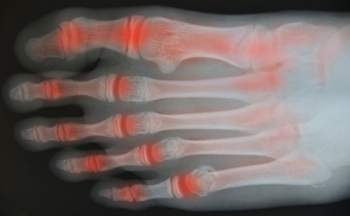 If you are experiencing pain and discomfort in your big toe, you may have a foot condition that is known as toe arthritis. It may be caused by wearing shoes that are too tight and may not have adequate room for the toes to move about in. One of the first signs that may be indicative of toe arthritis may be pain that is felt in the toes. Many people feel stiffness in the toes, and this may be a result of the diminished cartilage that is located between the joints, in addition to obvious redness and swelling of the toes and surrounding area. If you are afflicted with this condition, it may be difficult to perform daily activities that may include walking or standing for extended periods of time. If you are experiencing arthritis in your feet or toes, it is suggested to speak with a podiatrist who can advise you on correct treatment options.
If you are experiencing pain and discomfort in your big toe, you may have a foot condition that is known as toe arthritis. It may be caused by wearing shoes that are too tight and may not have adequate room for the toes to move about in. One of the first signs that may be indicative of toe arthritis may be pain that is felt in the toes. Many people feel stiffness in the toes, and this may be a result of the diminished cartilage that is located between the joints, in addition to obvious redness and swelling of the toes and surrounding area. If you are afflicted with this condition, it may be difficult to perform daily activities that may include walking or standing for extended periods of time. If you are experiencing arthritis in your feet or toes, it is suggested to speak with a podiatrist who can advise you on correct treatment options.
Arthritis can be a difficult condition to live with. If you are seeking treatment, contact Dr. Dean D. Hinners from Illinois. Our doctor can provide the care you need to keep you pain-free and on your feet.
Arthritic Foot Care
Arthritis is a term that is commonly used to describe joint pain. The condition itself can occur to anyone of any age, race, or gender, and there are over 100 types of it. Nevertheless, arthritis is more commonly found in women compared to men, and it is also more prevalent in those who are overweight. The causes of arthritis vary depending on which type of arthritis you have. Osteoarthritis for example, is often caused by injury, while rheumatoid arthritis is caused by a misdirected immune system.
Symptoms
- Swelling
- Pain
- Stiffness
- Decreased Range of Motion
Arthritic symptoms range in severity, and they may come and go. Some symptoms stay the same for several years but could potentially get worse with time. Severe cases of arthritis can prevent its sufferers from performing daily activities and make walking difficult.
Risk Factors
- Occupation – Occupations requiring repetitive knee movements have been linked to osteoarthritis
- Obesity – Excess weight can contribute to osteoarthritis development
- Infection – Microbial agents can infect the joints and trigger arthritis
- Joint Injuries – Damage to joints may lead to osteoarthritis
- Age – Risk increases with age
- Gender –Most types are more common in women
- Genetics – Arthritis can be hereditary
If you suspect your arthritis is affecting your feet, it is crucial that you see a podiatrist immediately. Your doctor will be able to address your specific case and help you decide which treatment method is best for you.
If you have any questions, please feel free to contact one of our offices located in Metropolis and Eldorado, IL . We offer the newest diagnostic and treatment technologies for all your foot care needs.
Read more about How to Care for Your Arthritic FootSeveral Ways to Develop Ankle Pain
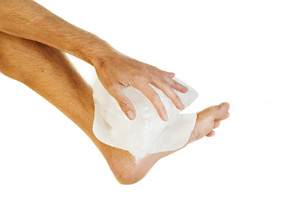 There are several injuries that may be experienced, which can precede uncomfortable ankle pain. These may include falling or tripping in which a fracture can occur, or a medical condition such as ankle arthritis. Throbbing, aching, or feeling a burning sensation may be a few of the noticeable symptoms that many people have, and it may progress gradually or be felt immediately. If you have stepped off a curb unexpectedly, tripped while participating in a sporting activity, or changed direction suddenly while running, you may have endured a form of ankle pain. It’s suggested to speak with a podiatrist as quickly as possible, so a correct diagnosis can be performed and treatment can begin.
There are several injuries that may be experienced, which can precede uncomfortable ankle pain. These may include falling or tripping in which a fracture can occur, or a medical condition such as ankle arthritis. Throbbing, aching, or feeling a burning sensation may be a few of the noticeable symptoms that many people have, and it may progress gradually or be felt immediately. If you have stepped off a curb unexpectedly, tripped while participating in a sporting activity, or changed direction suddenly while running, you may have endured a form of ankle pain. It’s suggested to speak with a podiatrist as quickly as possible, so a correct diagnosis can be performed and treatment can begin.
Ankle pain can be caused by a number of problems and may be potentially serious. If you have ankle pain, consult with Dr. Dean D. Hinners from Illinois. Our doctor will assess your condition and provide you with quality foot and ankle treatment.
Ankle pain is any condition that causes pain in the ankle. Due to the fact that the ankle consists of tendons, muscles, bones, and ligaments, ankle pain can come from a number of different conditions.
Causes
The most common causes of ankle pain include:
- Types of arthritis (rheumatoid, osteoarthritis, and gout)
- Ankle sprains
- Broken ankles
- Achilles tendinitis
- Achilles tendon rupture
- Stress fractures
- Bursitis
- Tarsal tunnel syndrome
- Plantar fasciitis
Symptoms
Symptoms of ankle injury vary based upon the condition. Pain may include general pain and discomfort, swelling, aching, redness, bruising, burning or stabbing sensations, and/or loss of sensation.
Diagnosis
Due to the wide variety of potential causes of ankle pain, podiatrists will utilize a number of different methods to properly diagnose ankle pain. This can include asking for personal and family medical histories and of any recent injuries. Further diagnosis may include sensation tests, a physical examination, and potentially x-rays or other imaging tests.
Treatment
Just as the range of causes varies widely, so do treatments. Some more common treatments are rest, ice packs, keeping pressure off the foot, orthotics and braces, medication for inflammation and pain, and surgery.
If you have any questions, please feel free to contact one of our offices located in Metropolis and Eldorado, IL . We offer the newest diagnostic and treatment technologies for all your foot care needs.
Read more about Ankle Pain
Foot Conditions Resulting from Aging Feet
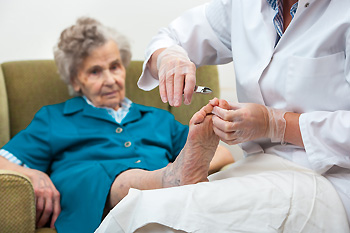 Research has shown that the feet of elderly people may develop foot conditions as the aging process occurs. This may be a result of a loss of cushioning that is found in the feet, in addition to changes in the toenails and skin. It’s important to wear shoes that are comfortable and fit properly, which may include eliminating high heels or shoes that have inadequate room for the toes to move about in. Circulation may improve when gentle foot stretches are performed throughout the day, in addition to wearing socks that are not too tight. There are several common ailments that may be prevalent to aging feet, including Athlete’s foot, cracked heels, and the formation of corns and calluses. Many seniors may become afflicted with the uncomfortable condition known as ingrown toenails, which may be a result of the toenails being cut improperly. Please consult with a podiatrist about effective techniques to properly care for elderly feet.
Research has shown that the feet of elderly people may develop foot conditions as the aging process occurs. This may be a result of a loss of cushioning that is found in the feet, in addition to changes in the toenails and skin. It’s important to wear shoes that are comfortable and fit properly, which may include eliminating high heels or shoes that have inadequate room for the toes to move about in. Circulation may improve when gentle foot stretches are performed throughout the day, in addition to wearing socks that are not too tight. There are several common ailments that may be prevalent to aging feet, including Athlete’s foot, cracked heels, and the formation of corns and calluses. Many seniors may become afflicted with the uncomfortable condition known as ingrown toenails, which may be a result of the toenails being cut improperly. Please consult with a podiatrist about effective techniques to properly care for elderly feet.
Proper foot care is something many older adults forget to consider. If you have any concerns about your feet and ankles, contact Dr. Dean D. Hinners from Illinois. Our doctor can provide the care you need to keep you pain-free and on your feet.
The Elderly and Their Feet
As we age we start to notice many changes in our body, but the elder population may not notice them right away. Medical conditions may prevent the elderly to take notice of their foot health right away. Poor vision is a lead contributor to not taking action for the elderly.
Common Conditions
- Neuropathy – can reduce feeling in the feet and can hide many life-threatening medical conditions.
- Reduced flexibility – prevents the ability of proper toenail trimming, and foot cleaning. If left untreated, it may lead to further medical issues.
- Foot sores – amongst the older population can be serious before they are discovered. Some of the problematic conditions they may face are:
- Gouging toenails affecting nearby toe
- Shoes that don’t fit properly
- Pressure sores
- Loss of circulation in legs & feet
- Edema & swelling of feet and ankles
Susceptible Infections
Diabetes and poor circulation can cause general loss of sensitivity over the years, turning a simple cut into a serious issue.
If you have any questions please feel free to contact one of our offices located in Metropolis and Eldorado, IL . We offer the newest diagnostic and treatment technologies for all your foot and ankle needs.
Read more about Taking Care of Elderly FeetGout Causes Severe Pain And Discomfort
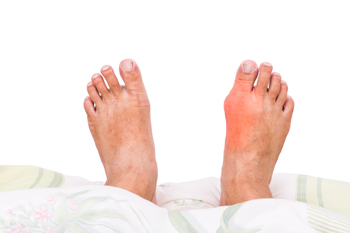 If you are afflicted with the medical condition referred to as gout, it may be a result of specific lifestyle habits. It will typically affect the joint in the bottom of the big toe, and is considered to be a form of arthritis. It may develop when the uric acid levels in the blood are elevated, and crystals may commonly form in the joints of the feet. This may produce severe pain and discomfort, and performing daily activities that include walking and running may prove to be extremely difficult. In addition to genetic traits contributing as a factor, there are several reasons why excess uric acid may form in the blood. These may include ingesting an overabundance of alcohol, eating too much red meat or shellfish, or having an inadequate amount of vitamin C in your diet. Treatment techniques may include elevating the foot to reduce any swelling, or using anti-inflammatory medicines that may provide moderate relief. If you are afflicted with this condition, it’s strongly suggested to speak with a podiatrist as quickly as possible so a proper diagnosis can be performed and correct treatments options can begin.
If you are afflicted with the medical condition referred to as gout, it may be a result of specific lifestyle habits. It will typically affect the joint in the bottom of the big toe, and is considered to be a form of arthritis. It may develop when the uric acid levels in the blood are elevated, and crystals may commonly form in the joints of the feet. This may produce severe pain and discomfort, and performing daily activities that include walking and running may prove to be extremely difficult. In addition to genetic traits contributing as a factor, there are several reasons why excess uric acid may form in the blood. These may include ingesting an overabundance of alcohol, eating too much red meat or shellfish, or having an inadequate amount of vitamin C in your diet. Treatment techniques may include elevating the foot to reduce any swelling, or using anti-inflammatory medicines that may provide moderate relief. If you are afflicted with this condition, it’s strongly suggested to speak with a podiatrist as quickly as possible so a proper diagnosis can be performed and correct treatments options can begin.
Gout is a painful condition that can be treated. If you are seeking treatment, contact Dr. Dean D. Hinners from Illinois. Our doctor will treat your foot and ankle needs.
What Is Gout?
Gout is a form of arthritis that is characterized by sudden, severe attacks of pain, redness, and tenderness in the joints. The condition usually affects the joint at the base of the big toe. A gout attack can occur at any random time, such as the middle of the night while you are asleep.
Symptoms
- Intense Joint Pain - Usually around the large joint of your big toe, and it most severe within the first four to twelve hours
- Lingering Discomfort - Joint discomfort may last from a few days to a few weeks
- Inflammation and Redness -Affected joints may become swollen, tender, warm and red
- Limited Range of Motion - May experience a decrease in joint mobility
Risk Factors
- Genetics - If family members have gout, you’re more likely to have it
- Medications - Diuretic medications can raise uric acid levels
- Gender/Age - Gout is more common in men until the age of 60. It is believed that estrogen protects women until that point
- Diet - Eating red meat and shellfish increases your risk
- Alcohol - Having more than two alcoholic drinks per day increases your risk
- Obesity - Obese people are at a higher risk for gout
Prior to visiting your podiatrist to receive treatment for gout, there are a few things you should do beforehand. If you have gout you should write down your symptoms--including when they started and how often you experience them, important medical information you may have, and any questions you may have. Writing down these three things will help your podiatrist in assessing your specific situation so that he or she may provide the best route of treatment for you.
If you have any questions, please feel free to contact one of our offices located in Metropolis and Eldorado, IL . We offer the newest diagnostic and treatment technologies for all your foot care needs.
Read more about Everything You Need to Know About GoutReasons That Ingrown Toenails May Occur
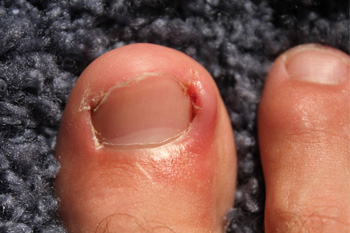 If you have ever experienced pain and tenderness on the side of your big toe, you may have what is known as an ingrown toenail. This is often the result of the toenail growing into the skin around the nail, and is often accompanied by pain and discomfort. If the toenail is severely ingrown, some of the symptoms experienced may be pus oozing from the area, swelling, or extensive bleeding. It is advised for diabetic patients to seek medical treatment immediately, which will aid in promoting proper healing. There are several causes of ingrown toenails, including wearing shoes and socks that fit too tightly, incurring an injury to the toe, or by having feet that sweat excessively. The latter reason typically allows the nail to cut through the soft skin surrounding it, and implants itself into the skin. If you feel you have an ingrown toenail, please consult with a podiatrist to learn about proper treatment techniques.
If you have ever experienced pain and tenderness on the side of your big toe, you may have what is known as an ingrown toenail. This is often the result of the toenail growing into the skin around the nail, and is often accompanied by pain and discomfort. If the toenail is severely ingrown, some of the symptoms experienced may be pus oozing from the area, swelling, or extensive bleeding. It is advised for diabetic patients to seek medical treatment immediately, which will aid in promoting proper healing. There are several causes of ingrown toenails, including wearing shoes and socks that fit too tightly, incurring an injury to the toe, or by having feet that sweat excessively. The latter reason typically allows the nail to cut through the soft skin surrounding it, and implants itself into the skin. If you feel you have an ingrown toenail, please consult with a podiatrist to learn about proper treatment techniques.
Ingrown toenails can become painful if they are not treated properly. For more information about ingrown toenails, contact Dr. Dean D. Hinners of Illinois. Our doctor can provide the care you need to keep you pain-free and on your feet.
Ingrown Toenails
Ingrown toenails occur when a toenail grows sideways into the bed of the nail, causing pain, swelling, and possibly infection.
Causes
- Bacterial infections
- Improper nail cutting such as cutting it too short or not straight across
- Trauma to the toe, such as stubbing, which causes the nail to grow back irregularly
- Ill-fitting shoes that bunch the toes too close together
- Genetic predisposition
Prevention
Because ingrown toenails are not something found outside of shoe-wearing cultures, going barefoot as often as possible will decrease the likeliness of developing ingrown toenails. Wearing proper fitting shoes and using proper cutting techniques will also help decrease your risk of developing ingrown toenails.
Treatment
Ingrown toenails are a very treatable foot condition. In minor cases, soaking the affected area in salt or antibacterial soaps will not only help with the ingrown nail itself, but also help prevent any infections from occurring. In more severe cases, surgery is an option. In either case, speaking to your podiatrist about this condition will help you get a better understanding of specific treatment options that are right for you.
If you have any questions please feel free to contact one of our offices located in Metropolis and Eldorado, IL . We offer the newest diagnostic and treatment technologies for all your foot and ankle needs.
Read more about Ingrown Toenail CareIs There A Link Between Obesity and Toenail Fungus?
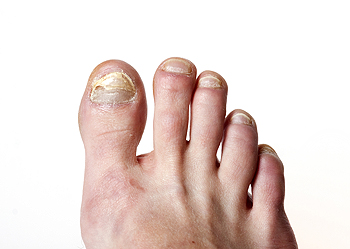 Researchers in Korea have found that excessive weight gain may lead to the unsightly condition known as onychomycosis, which is also referred to as toenail fungus. In patients who are diabetic, this condition may be painful and may lead to the development of additional infections. It may be beneficial to treat this ailment as early as possible and this may be accomplished by using a topical medicine. In more advanced cases, injections may be necessary to administer around the nail bed. Toenail fungus is typically not life-threatening, and there may be moderate symptoms that may accompany this condition. The most noticeable signs may be a thickening of the toenail, and may often appear black in color as the infection progresses. If you feel you have this condition, it’s advised to consult with a podiatrist who can recommend the best course of treatment for you.
Researchers in Korea have found that excessive weight gain may lead to the unsightly condition known as onychomycosis, which is also referred to as toenail fungus. In patients who are diabetic, this condition may be painful and may lead to the development of additional infections. It may be beneficial to treat this ailment as early as possible and this may be accomplished by using a topical medicine. In more advanced cases, injections may be necessary to administer around the nail bed. Toenail fungus is typically not life-threatening, and there may be moderate symptoms that may accompany this condition. The most noticeable signs may be a thickening of the toenail, and may often appear black in color as the infection progresses. If you feel you have this condition, it’s advised to consult with a podiatrist who can recommend the best course of treatment for you.
If left untreated, toenail fungus may spread to other toenails, skin, or even fingernails. If you suspect you have toenail fungus it is important to seek treatment right away. For more information about treatment, contact Dr. Dean D. Hinners of Illinois. Our doctor can provide the care you need to keep you pain-free and on your feet.
Symptoms
- Warped or oddly shaped nails
- Yellowish nails
- Loose/separated nail
- Buildup of bits and pieces of nail fragments under the nail
- Brittle, broken, thickened nail
Treatment
If self-care strategies and over-the-counter medications does not help your fungus, your podiatrist may give you a prescription drug instead. Even if you find relief from your toenail fungus symptoms, you may experience a repeat infection in the future.
Prevention
In order to prevent getting toenail fungus in the future, you should always make sure to wash your feet with soap and water. After washing, it is important to dry your feet thoroughly especially in between the toes. When trimming your toenails, be sure to trim straight across instead of in a rounded shape. It is crucial not to cover up discolored nails with nail polish because that will prevent your nail from being able to “breathe”.
In some cases, surgical procedure may be needed to remove the toenail fungus. Consult with your podiatrist about the best treatment options for your case of toenail fungus.
If you have any questions, please feel free to contact one of our offices located in Metropolis and Eldorado, IL . We offer the newest diagnostic and treatment technologies for all your foot care needs.
Read more about Treating Toenail Fungus
Is Rheumatoid Arthritis Common?
 One of the most common types of arthritis is referred to as rheumatoid arthritis. Many people may experience symptoms of this condition in the feet and are aware of the pain and discomfort that typically exists with this ailment. There are specific symptoms that may accompany this type of arthritis, including swelling and soreness in the feet, difficulty waking, which may be a result of unstable joints, or the foot possibly changing shape. Research has shown the part of the foot that may be affected the most are the toes, which consist of smaller joints. They may begin to look deformed and may have difficulty in moving or bending. There may be additional foot conditions that may arise including the development of corns and calluses. This may be a result of changes in the foot shape. If you are afflicted with rheumatoid arthritis, it is suggested to consult with a podiatrist who can offer proper treatment techniques.
One of the most common types of arthritis is referred to as rheumatoid arthritis. Many people may experience symptoms of this condition in the feet and are aware of the pain and discomfort that typically exists with this ailment. There are specific symptoms that may accompany this type of arthritis, including swelling and soreness in the feet, difficulty waking, which may be a result of unstable joints, or the foot possibly changing shape. Research has shown the part of the foot that may be affected the most are the toes, which consist of smaller joints. They may begin to look deformed and may have difficulty in moving or bending. There may be additional foot conditions that may arise including the development of corns and calluses. This may be a result of changes in the foot shape. If you are afflicted with rheumatoid arthritis, it is suggested to consult with a podiatrist who can offer proper treatment techniques.
Because RA affects more than just your joints, including the joints in your feet and ankles, it is important to seek early diagnosis from your podiatrist if you feel like the pain in your feet might be caused by RA. For more information, contact Dr. Dean D. Hinners of Illinois. Our doctor will assist you with all of your podiatric concerns.
What Is Rheumatoid Arthritis?
Rheumatoid Arthritis (RA) is an autoimmune disorder in which the body’s own immune system attacks the membranes surrounding the joints. Inflammation of the lining and eventually the destruction of the joint’s cartilage and bone occur, causing severe pain and immobility.
Rheumatoid Arthritis of the Feet
Although RA usually attacks multiple bones and joints throughout the entire body, almost 90 percent of cases result in pain in the foot or ankle area.
Symptoms
- Swelling and pain in the feet
- Stiffness in the feet
- Pain on the ball or sole of feet
- Joint shift and deformation
Diagnosis
Quick diagnosis of RA in the feet is important so that the podiatrist can treat the area effectively. Your doctor will ask you about your medical history, occupation, and lifestyle to determine the origin of the condition. Rheumatoid Factor tests help to determine if someone is affected by the disease.
If you have any questions please feel free to contact one of our offices located in Metropolis and Eldorado, IL . We offer the newest diagnostic and treatment technologies for all your foot and ankle needs.
Read more about Rheumatoid Arthritis in the FeetIs There A Reduction of Bunions in Non-Western Countries?
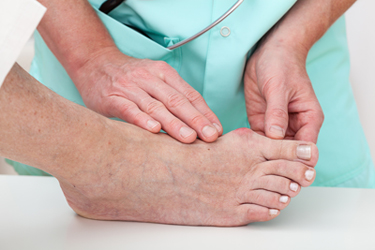 If you notice a large bony protrusion on the side of your big toe, you may have what is referred to as a bunion. It is considered to be a deformity, and there may be several reasons why this condition may occur. Research has shown that genetics may play a significant role in the formation of bunions. If you happen to have a pre-existing case of bunions, wearing shoes that do not fit correctly could possibly make it even worse. This type of footwear may include shoes that have a narrow toe area, which does not have adequate room for the toes to move about in. This may result in the toes being forced to squeeze into an area that is too small. There is a significant reduction in the development of bunions in non-western countries and this may be a result of wearing shoes that fit correctly. If you feel you have a bunion, it’s suggested to speak with a podiatrist who can begin treatment options that are right for you.
If you notice a large bony protrusion on the side of your big toe, you may have what is referred to as a bunion. It is considered to be a deformity, and there may be several reasons why this condition may occur. Research has shown that genetics may play a significant role in the formation of bunions. If you happen to have a pre-existing case of bunions, wearing shoes that do not fit correctly could possibly make it even worse. This type of footwear may include shoes that have a narrow toe area, which does not have adequate room for the toes to move about in. This may result in the toes being forced to squeeze into an area that is too small. There is a significant reduction in the development of bunions in non-western countries and this may be a result of wearing shoes that fit correctly. If you feel you have a bunion, it’s suggested to speak with a podiatrist who can begin treatment options that are right for you.
If you are suffering from bunions, contact Dr. Dean D. Hinners of Illinois. Our doctor can provide the care you need to keep you pain-free and on your feet.
What Is a Bunion?
A bunion is formed of swollen tissue or an enlargement of boney growth, usually located at the base joint of the toe that connects to the foot. The swelling occurs due to the bones in the big toe shifting inward, which impacts the other toes of the foot. This causes the area around the base of the big toe to become inflamed and painful.
Why Do Bunions Form?
Genetics – Susceptibility to bunions are often hereditary
Stress on the feet – Poorly fitted and uncomfortable footwear that places stress on feet, such as heels, can worsen existing bunions
How Are Bunions Diagnosed?
Doctors often perform two tests – blood tests and x-rays – when trying to diagnose bunions, especially in the early stages of development. Blood tests help determine if the foot pain is being caused by something else, such as arthritis, while x-rays provide a clear picture of your bone structure to your doctor.
How Are Bunions Treated?
- Refrain from wearing heels or similar shoes that cause discomfort
- Select wider shoes that can provide more comfort and reduce pain
- Anti-inflammatory and pain management drugs
- Orthotics or foot inserts
- Surgery
If you have any questions, please feel free to contact one of our offices located in Metropolis and Eldorado, IL . We offer the newest diagnostic and treatment technologies for all your foot care needs.
Read more about BunionsCauses and Symptoms of a Broken Foot
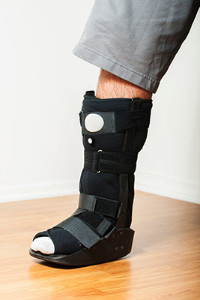 People who have broken their foot are most likely familiar with the severe pain and discomfort that may be associated with this condition. Typical symptoms of this type of fracture may include swelling, bruising and the inability to walk on the foot. The most common reasons for this to occur may be from a fall or from overuse, which may be a result of consistent running and jumping. If you feel you have broken your foot, a proper diagnosis must be performed, which will determine the severity of the fracture. This is accomplished by having an X-ray, CT scan or bone scan taken. When this occurs, proper treatment may begin, which may include wearing a cast or a supportive boot. In severe breaks where the bone protrudes from the skin, surgery may be a necessary option to repair any damage the foot has incurred. It is suggested to speak with a podiatrist if you have broken your foot and would like to learn about treatment options that are correct for you.
People who have broken their foot are most likely familiar with the severe pain and discomfort that may be associated with this condition. Typical symptoms of this type of fracture may include swelling, bruising and the inability to walk on the foot. The most common reasons for this to occur may be from a fall or from overuse, which may be a result of consistent running and jumping. If you feel you have broken your foot, a proper diagnosis must be performed, which will determine the severity of the fracture. This is accomplished by having an X-ray, CT scan or bone scan taken. When this occurs, proper treatment may begin, which may include wearing a cast or a supportive boot. In severe breaks where the bone protrudes from the skin, surgery may be a necessary option to repair any damage the foot has incurred. It is suggested to speak with a podiatrist if you have broken your foot and would like to learn about treatment options that are correct for you.
A broken foot requires immediate medical attention and treatment. If you need your feet checked, contact Dr. Dean D. Hinners from Illinois. Our doctor can provide the care you need to keep you pain-free and on your feet.
Broken Foot Causes, Symptoms, and Treatment
A broken foot is caused by one of the bones in the foot typically breaking when bended, crushed, or stretched beyond its natural capabilities. Usually the location of the fracture indicates how the break occurred, whether it was through an object, fall, or any other type of injury.
Common Symptoms of Broken Feet:
- Bruising
- Pain
- Redness
- Swelling
- Blue in color
- Numbness
- Cold
- Misshapen
- Cuts
- Deformities
Those that suspect they have a broken foot shoot seek urgent medical attention where a medical professional could diagnose the severity.
Treatment for broken bones varies depending on the cause, severity and location. Some will require the use of splints, casts or crutches while others could even involve surgery to repair the broken bones. Personal care includes the use of ice and keeping the foot stabilized and elevated.
If you have any questions please feel free to contact one of our offices located in Metropolis and Eldorado, IL . We offer the newest diagnostic and treatment technologies for all your foot and ankle needs.
Read more about Causes, Symptoms, and Treatment for a Broken FootWhy is it Important for Seniors to Maintain Proper Foot Care?
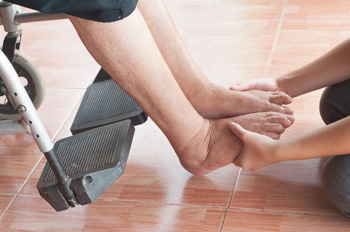 There are several ways seniors can practice proper foot care. These may include wearing shoes that fit correctly and are comfortable to wear during daily activities. It’s important the toes have adequate room to move around inside, and this may possibly avoid a pre-existing case of bunions from becoming worse. It may also prevent corns from developing. Additionally, performing a gentle exercise program frequently, may aid in keeping the blood flowing. These may include walking and stretching, which may help to maintain proper circulation. Washing the feet and drying thoroughly between the toes may be beneficial in preventing athlete’s foot from developing. When a moisturizing lotion is used, a painful condition referred to as cracked heels may be avoided. When the toenails are trimmed properly, occurrences of ingrown toenails may decrease. If you are a senior, it’s suggested to consult with a podiatrist on a frequent basis to discuss any foot conditions that may be present.
There are several ways seniors can practice proper foot care. These may include wearing shoes that fit correctly and are comfortable to wear during daily activities. It’s important the toes have adequate room to move around inside, and this may possibly avoid a pre-existing case of bunions from becoming worse. It may also prevent corns from developing. Additionally, performing a gentle exercise program frequently, may aid in keeping the blood flowing. These may include walking and stretching, which may help to maintain proper circulation. Washing the feet and drying thoroughly between the toes may be beneficial in preventing athlete’s foot from developing. When a moisturizing lotion is used, a painful condition referred to as cracked heels may be avoided. When the toenails are trimmed properly, occurrences of ingrown toenails may decrease. If you are a senior, it’s suggested to consult with a podiatrist on a frequent basis to discuss any foot conditions that may be present.
Proper foot care is something many older adults forget to consider. If you have any concerns about your feet and ankles, contact Dr. Dean D. Hinners from Illinois. Our doctor can provide the care you need to keep you pain-free and on your feet.
The Elderly and Their Feet
As we age we start to notice many changes in our body, but the elder population may not notice them right away. Medical conditions may prevent the elderly to take notice of their foot health right away. Poor vision is a lead contributor to not taking action for the elderly.
Common Conditions
- Neuropathy – can reduce feeling in the feet and can hide many life-threatening medical conditions.
- Reduced flexibility – prevents the ability of proper toenail trimming, and foot cleaning. If left untreated, it may lead to further medical issues.
- Foot sores – amongst the older population can be serious before they are discovered. Some of the problematic conditions they may face are:
- Gouging toenails affecting nearby toe
- Shoes that don’t fit properly
- Pressure sores
- Loss of circulation in legs & feet
- Edema & swelling of feet and ankles
Susceptible Infections
Diabetes and poor circulation can cause general loss of sensitivity over the years, turning a simple cut into a serious issue.
If you have any questions please feel free to contact one of our offices located in Metropolis and Eldorado, IL . We offer the newest diagnostic and treatment technologies for all your foot and ankle needs.
Read more about Elderly Foot CareMore...
Different Types of Foot Pain
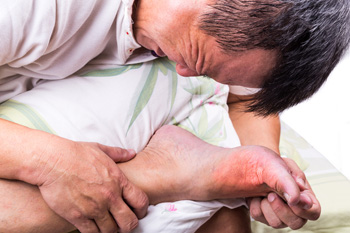 There are several different types of foot pain that many people experience. Some patients may feel pain that radiates in the entire foot, which may be caused by a condition that is referred to as neuropathy. This may occur among diabetic patients as a result of elevated blood sugar levels, and may cause nerve damage. Additionally, if the pain is located in the ball of the foot, a condition known as Metatarsalgia may develop. This commonly occurs as a result of wearing shoes that do not fit correctly. Gout, hammertoe, or bunions may cause toe pain, and proper treatment may include adapting a lifestyle change or taking prescription medications. A common form of heel pain may be indicative of plantar fasciitis, which typically affects the tissue that links the heel and the toes together. It’s suggested that if you are experiencing any type of foot pain, a consultation with a podiatrist will be helpful in determining the best course of treatment.
There are several different types of foot pain that many people experience. Some patients may feel pain that radiates in the entire foot, which may be caused by a condition that is referred to as neuropathy. This may occur among diabetic patients as a result of elevated blood sugar levels, and may cause nerve damage. Additionally, if the pain is located in the ball of the foot, a condition known as Metatarsalgia may develop. This commonly occurs as a result of wearing shoes that do not fit correctly. Gout, hammertoe, or bunions may cause toe pain, and proper treatment may include adapting a lifestyle change or taking prescription medications. A common form of heel pain may be indicative of plantar fasciitis, which typically affects the tissue that links the heel and the toes together. It’s suggested that if you are experiencing any type of foot pain, a consultation with a podiatrist will be helpful in determining the best course of treatment.
Foot Pain
Foot pain can be extremely painful and debilitating. If you have a foot pain, consult with Dr. Dean D. Hinners from Illinois. Our doctor will assess your condition and provide you with quality foot and ankle treatment.
Causes
Foot pain is a very broad condition that could be caused by one or more ailments. The most common include:
- Bunions
- Hammertoes
- Plantar Fasciitis
- Bone Spurs
- Corns
- Tarsal Tunnel Syndrome
- Ingrown Toenails
- Arthritis (such as Gout, Rheumatoid, and Osteoarthritis)
- Flat Feet
- Injury (from stress fractures, broken toe, foot, ankle, Achilles tendon ruptures, and sprains)
- And more
Diagnosis
To figure out the cause of foot pain, podiatrists utilize several different methods. This can range from simple visual inspections and sensation tests to X-rays and MRI scans. Prior medical history, family medical history, and any recent physical traumatic events will all be taken into consideration for a proper diagnosis.
Treatment
Treatment depends upon the cause of the foot pain. Whether it is resting, staying off the foot, or having surgery; podiatrists have a number of treatment options available for foot pain.
If you have any questions, please feel free to contact one of our offices located in Metropolis and Eldorado, IL . We offer the newest diagnostic and treatment technologies for all your foot care needs.
Read more about Foot PainFoot Conditions That May Occur as a Result of Wearing Flip Flops
 The type of footwear referred to as flip flops are popular summer shoes that are made of thin soles and typically are not meant to be worn for extended periods of time. Despite the fact that many people indulge in wearing these types of shoes, there may be moderate discomfort and symptoms that can be associated with them. These may include an achy feeling that may be present in the foot and ankle in addition to the formation of calluses and blisters. Other foot conditions that may develop as a result of wearing flip flops may be the development of bunions and hammertoes. The risk of injury may be increased from choosing to wear this type of shoe and this may occur as a result of a lack of stability. If you have questions pertaining to flip flops and would like additional information about the pros and cons for wearing this type of shoe, please schedule an appointment with a podiatrist who will be able to answer any questions you may have.
The type of footwear referred to as flip flops are popular summer shoes that are made of thin soles and typically are not meant to be worn for extended periods of time. Despite the fact that many people indulge in wearing these types of shoes, there may be moderate discomfort and symptoms that can be associated with them. These may include an achy feeling that may be present in the foot and ankle in addition to the formation of calluses and blisters. Other foot conditions that may develop as a result of wearing flip flops may be the development of bunions and hammertoes. The risk of injury may be increased from choosing to wear this type of shoe and this may occur as a result of a lack of stability. If you have questions pertaining to flip flops and would like additional information about the pros and cons for wearing this type of shoe, please schedule an appointment with a podiatrist who will be able to answer any questions you may have.
Flip-flops can cause a lot of problems for your feet. If you have any concerns about your feet or ankles, contact Dr. Dean D. Hinners from Illinois. Our doctor will assist you with all of your foot and ankle needs.
Flip-Flops and Feet
Flip-flops have managed to become a summer essential for a lot of people. While the shoes may be stylish and easy to slip on and off, they can be dangerous to those who wear them too often. These shoes might protect you from fungal infections such as athlete’s foot, but they can also give you foot pain and sprained ankles if you trip while wearing them.
When Are They Okay to Wear?
Flip-flops should only be worn for very short periods of time. They can help protect your feet in places that are crawling with fungi, such as gym locker rooms. Athlete’s foot and plantar warts are two common fungi that flip-flops may help protect your feet against.
Why Are They Bad for My Feet?
These shoes do not offer any arch support, so they are not ideal for everyday use. They also do not provide shock absorption or heel cushioning which can be problematic for your feet. Additionally, you may suffer from glass cuts, puncture wounds, and stubbed toes since they offer little protection for your feet.
More Reasons Why They Are Bad for Your Feet
- They Slow You Down
- May Cause Blisters and Calluses
- Expose Your Feet to Bacteria
If you have any questions, please feel free to contact one of our offices located in Metropolis and Eldorado, IL . We offer the newest diagnostic and treatment technologies for all your foot care needs.
Read more about Flipping Out About Flip FlopsWhat Foods to Avoid if You are Afflicted with Gout
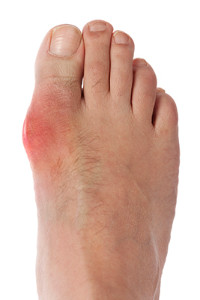 When specific foods are ingested on a frequent basis, a flare-up of a condition known as gout may occur. There are several symptoms that accompany this ailment, including severe pain and discomfort surrounding the big toe, redness, and extreme tenderness when the area is touched. Certain foods have elevated levels of purines, which is known to raise uric acid levels in the blood. This causes crystals to form, and may lodge in the joints of the feet, most commonly the big toe. Research has shown that certain foods should be limited or avoided, which are high in purine levels. These may include alcohol, shellfish, and meat. For patients who experience gout, it may be advised to drink plenty of fresh water frequently, increase the amount of fruits and vegetables that are eaten on a daily basis, and to lose weight slowly if obesity is a factor. Please schedule a consultation with a podiatrist if you are afflicted with gout for immediate treatment options.
When specific foods are ingested on a frequent basis, a flare-up of a condition known as gout may occur. There are several symptoms that accompany this ailment, including severe pain and discomfort surrounding the big toe, redness, and extreme tenderness when the area is touched. Certain foods have elevated levels of purines, which is known to raise uric acid levels in the blood. This causes crystals to form, and may lodge in the joints of the feet, most commonly the big toe. Research has shown that certain foods should be limited or avoided, which are high in purine levels. These may include alcohol, shellfish, and meat. For patients who experience gout, it may be advised to drink plenty of fresh water frequently, increase the amount of fruits and vegetables that are eaten on a daily basis, and to lose weight slowly if obesity is a factor. Please schedule a consultation with a podiatrist if you are afflicted with gout for immediate treatment options.
Gout is a foot condition that requires certain treatment and care. If you are seeking treatment, contact Dr. Dean D. Hinners from Illinois. Our doctor will treat your foot and ankle needs.
What Is Gout?
Gout is a type of arthritis caused by a buildup of uric acid in the bloodstream. It often develops in the foot, especially the big toe area, although it can manifest in other parts of the body as well. Gout can make walking and standing very painful and is especially common in diabetics and the obese.
People typically get gout because of a poor diet. Genetic predisposition is also a factor. The children of parents who have had gout frequently have a chance of developing it themselves.
Gout can easily be identified by redness and inflammation of the big toe and the surrounding areas of the foot. Other symptoms include extreme fatigue, joint pain, and running high fevers. Sometimes corticosteroid drugs can be prescribed to treat gout, but the best way to combat this disease is to get more exercise and eat a better diet.
If you have any questions please feel free to contact one of our offices located in Metropolis and Eldorado, IL . We offer the newest diagnostic and treatment technologies for all your foot and ankle needs.
Read more about GoutSwollen Feet During Pregnancy is Natural
 Despite weight gain being a natural occurrence during pregnancy, many women often notice abnormal swelling in their feet. This is partially due to women experiencing a change in their center of gravity, which may prompt a difference in standing and walking. The feet can enlarge and should be measured regularly, so the correct shoe size can be worn for maximum comfort. This may prevent certain uncomfortable foot conditions from occurring such as ingrown toenails, and it can prevent an existing case of bunions from becoming worse. There may be several ways to control unwanted swollen feet. Many women may find relief by elevating their feet frequently, practicing a healthy lifestyle that includes consuming foods with a lower sodium content, and exercising regularly. Additionally, wearing comfortable shoes may aid in providing additional support for the feet and general health of the body. If you would like additional information about how pregnancy affects the feet, please consult with a podiatrist.
Despite weight gain being a natural occurrence during pregnancy, many women often notice abnormal swelling in their feet. This is partially due to women experiencing a change in their center of gravity, which may prompt a difference in standing and walking. The feet can enlarge and should be measured regularly, so the correct shoe size can be worn for maximum comfort. This may prevent certain uncomfortable foot conditions from occurring such as ingrown toenails, and it can prevent an existing case of bunions from becoming worse. There may be several ways to control unwanted swollen feet. Many women may find relief by elevating their feet frequently, practicing a healthy lifestyle that includes consuming foods with a lower sodium content, and exercising regularly. Additionally, wearing comfortable shoes may aid in providing additional support for the feet and general health of the body. If you would like additional information about how pregnancy affects the feet, please consult with a podiatrist.
Pregnant women with swollen feet can be treated with a variety of different methods that are readily available. For more information about other cures for swollen feet during pregnancy, consult with Dr. Dean D. Hinners from Illinois. Our doctor will attend to all of your foot and ankle needs.
What Foot Problems Can Arise During Pregnancy?
One problem that can occur is overpronation, which occurs when the arch of the foot flattens and tends to roll inward. This can cause pain and discomfort in your heels while you’re walking or even just standing up, trying to support your baby.
Another problem is edema, or swelling in the extremities. This often affects the feet during pregnancy but tends to occur in the later stages.
How Can I Keep My Feet Healthy During Pregnancy?
- Wearing orthotics can provide extra support for the feet and help distribute weight evenly
- Minimize the amount of time spent walking barefoot
- Wear shoes with good arch support
- Wear shoes that allow for good circulation to the feet
- Elevate feet if you experience swelling
- Massage your feet
- Get regular, light exercise, such as walking, to promote blood circulation to the feet
If you have any questions please feel free to contact one of our offices located in Metropolis and Eldorado, IL . We offer the newest diagnostic and treatment technologies for all your foot and ankle needs.
Read more about Pregnancy and Foot Health